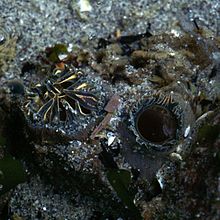Tresus capax: Difference between revisions
Jelly Beanie (talk | contribs) too big! |
GrahamBould (talk | contribs) mNo edit summary |
||
| Line 63: | Line 63: | ||
* {{cite web | last =Nash | first =Pat | coauthors = | date =2004-01-15 | year = | month = | url=http://www.beachwatchers.wsu.edu/beachnow/gaper_clam.htm | title ="At the Beach Now: Horse? Or Gaper Clams" | work = | publisher =Washington State University | accessdate =2006-08-06}} |
* {{cite web | last =Nash | first =Pat | coauthors = | date =2004-01-15 | year = | month = | url=http://www.beachwatchers.wsu.edu/beachnow/gaper_clam.htm | title ="At the Beach Now: Horse? Or Gaper Clams" | work = | publisher =Washington State University | accessdate =2006-08-06}} |
||
* {{cite web | last = | first = | coauthors = | date =2000 | year = | month = | url=http://wdfw.wa.gov/fish/shelfish/beachreg/1clam.htm | title ="Shellfish" | work = | publisher =Washington Department of Fish and Wildlife | accessdate =2006-08-06}} |
* {{cite web | last = | first = | coauthors = | date =2000 | year = | month = | url=http://wdfw.wa.gov/fish/shelfish/beachreg/1clam.htm | title ="Shellfish" | work = | publisher =Washington Department of Fish and Wildlife | accessdate =2006-08-06}} |
||
== Further reading == |
== Further reading == |
||
| Line 69: | Line 68: | ||
* [http://www.geoduck.org/Content_Frames/science.html Science: Geoduck and Horseclam Biology], an overview by Underwater Harvesters Association, British Columbia, developers of underwater farming. |
* [http://www.geoduck.org/Content_Frames/science.html Science: Geoduck and Horseclam Biology], an overview by Underwater Harvesters Association, British Columbia, developers of underwater farming. |
||
[[Category: |
[[Category:Hiatellidae]] |
||
[[Category:Edible molluscs]] |
[[Category:Edible molluscs]] |
||
Revision as of 20:08, 5 December 2007
| Horse clam | |
|---|---|

| |
| Siphons of T. capax | |
| Scientific classification | |
| Kingdom: | |
| Phylum: | |
| Class: | |
| Order: | |
| Family: | |
| Genus: | |
| Species: | T. nuttallii and T. capax
|
| Binomial name | |
| Tresus nuttallii and Tresus capax | |
The horse clam (Tresus nuttallii and T. capax) are related to the Geoduck, though smaller, with shells up to eight inches long (20 cm), weight to 3–4 lb (1.4–1.8 kg). Two similar species of horse clams inhabit the Salish Sea and Pacific coast intertidal zones: the pacific gaper, Tresus nuttallii, more abundant south to California; and the fat gaper, T. capax, more abundant north to Alaska. Both have oval and chalky-white or yellow shells with patches of brown periostracum (leather-like skin) on the shell. Horse clams are called gapers because their shells are flared around the siphon and do not completely close, rather like geoducks. Like geoducks, they are unable to completely retract the siphon within the shell, though less flagrantly.
Identification
An easy way to tell the two species apart is that T. nuttallii usually has relatively longer, narrower shells (longer compared to height) and larger siphonal plates (horny plates found at the tip of the siphon, often with a little algae or barnacles garden). Hence T. capax is the fat gaper.
Their habitat is the lower intertidal zones on out to waters as deep as 50–60 feet (13-15 m). They prefer sand, mud, and gravel substrates, normally burying themselves 12–16 inches (30–41 cm), so they are much easier to dig than geoducks. Their preferred substrates are also preferred by butter and littleneck clams, so horse clams are often taken incidentally in commercial harvesting . Horse clams often have a relationship with small commensal pea crabs, often a mating pair, which co-habitate with the horse clam. The crabs are easily seen and in no way affect the clam as food. The meat is good and makes excllent chowder. They tend to be ignored by sport diggers in Washington but not in Oregon.
Horse clams are broadcast spawners like geoducks; T. nuttali spawn in summer and T. capax in winter.[1]
Appreciated by pre-contact local Native Americans for their size, abundance, and relatively easy capture, they are less sought today than geoducks, which have gained a marketing cachet.
Harvesting
Identification is important. Best recipes vary with species. For resource sustainablitily, the Washington State Department of Fish and Wildlife [1] sets size and bag limits for clams. The Department of Health sometimes closes beaches for public health and safety. The Department of Health Marine Biotoxin web site [2] has current information.
King County has a well-illustrated clam identification procedure [3].[2]
Some clammers find horse clams are not as tasty as others, so it's not unusual during clamming season to find horse clams left behind on the beach. The shells are more fragile than they might appear, so it is critical that they not be damaged when first digging if they are not kept. The clams will soon die if abandoned. The adults are unable to rebury themselves—they need the pressure of their surroundings to remain intact and maneuver. They can't hold their two big valves together, protecting their soft tissues. Responsible diggers carefully rebury them to about the depth at which the clams were found. Diggers should fill all of the holes that they dig.[3]
See also
Notes and references
Bibliography
- Brenner, Bob (1998-11-02 updated). ""Beach Assessment Clam Identification Key"". King County. Retrieved 2006-08-06.
{{cite web}}: Check date values in:|date=(help); Cite has empty unknown parameters:|coauthors=and|month=(help) - Nash, Pat (2004-01-15). ""At the Beach Now: Horse? Or Gaper Clams"". Washington State University. Retrieved 2006-08-06.
{{cite web}}: Cite has empty unknown parameters:|coauthors=and|month=(help) - ""Shellfish"". Washington Department of Fish and Wildlife. 2000. Retrieved 2006-08-06.
{{cite web}}: Cite has empty unknown parameters:|coauthors=and|month=(help)
Further reading
- Abbreviated edition of the clam identification key by the Washington State Department of Fish and Wildlife at the King County Department of Natural Resources
- Science: Geoduck and Horseclam Biology, an overview by Underwater Harvesters Association, British Columbia, developers of underwater farming.
